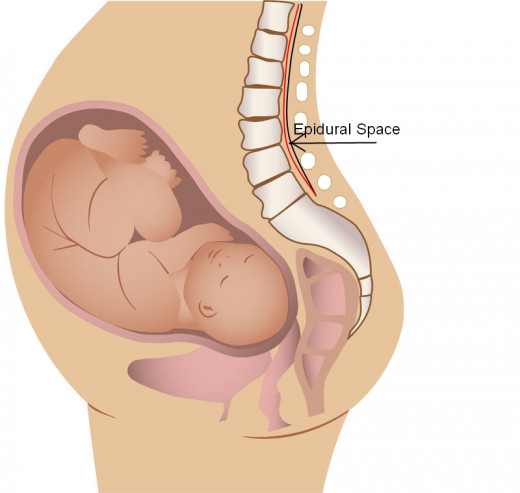- HubPages»
- Health»
- Women's Health»
- Pregnancy
What is an Epidural?
An Epidural is a form of pain relief that is used in labour. It involves numbing the nerves that lead to your tummy and pelvic area as well as your womb.
It is the most complicated form of pain relief and is set up by an anaesthetist who carefully places a fine tube into the epidural space. The anaesthetic is pumped through which numbs the nerves leading to your abdomen. As you are numb around your abdomen then you will not feel any pain. Not all women need this level of analgesia and it will not harm your baby.

Who can have an Epidural?
Most women can have an Epidural, but there are certain complications of pregnancy and bleeding disorders that may make it unsuitable. If you have a complicated or long labour your midwife or obstetrician may recommend that you have one. In such circumstances it will benefit you and your baby.
What does having an Epidural Involve?
Before an epidural can be inserted a drip needs to be put up initially so that your blood pressure is maintained. Epidurals can lower blood pressure as the drug used opens up all the blood vessels in the body causing it to drop suddenly. Iv fluids will keep your blood pressure up so that your body will cope with the drop caused by the epidural.
- The anaesthetist will ask you to sit on the side of the bed or they may ask you to lie down on your side curled around. The reason why they ask you to do this is to open up your spine so that the anaesthetist can get into the epidural spaces.
- Your back will be cleaned with an antiseptic and the area made sterile around you.
- The anaesthetist will then feel around your back area for the spaces between the spines and a local anaesthetic is given by a small needle to the skin around that area.
- The epidural needle is then inserted, this is actually a hollow needle and once the needle is in the correct place then a very fine tube is passed down the needle. Once the tube is in the correct space then the needle is removed and what is left is the tube.
- This process needs absolute precision and it is very important to listen to what the anaesthetist is telling you and to keep as still as you can. If you are having an epidural through your labour the midwife and anaesthetist will be able to guide you through your contractions and you can still use the gas and air. The epidural can be sited in between your contractions.
- Once the epidural is in place the anaesthetist will set it up on a PCA (Patient Controlled Analgesia) pump and give you a button to press so that you can control the amount of epidural that goes in. The pain relieving drug numb the nerves in your back that supply the pelvic area and the uterus and you will be numb from the waist to the top of your legs.
- The midwife will also take your blood pressure regularly to monitor any drops in BP, you will also be monitored continuously to assess your baby.
- The epidural can take around 20-30 minutes to work and you will find that whilst it is starting to work that your contractions will become less painful. You will be aware that your tummy is still tightening, however there should be no pain at all.
- There are some occasions where the epidural will not work and it may need re-siting, or some adjustments may be needed.
- An epidural should not make you drowsy and you are less likely to be sick, itching rarely occurs.
- If you have high blood pressure then an epidural is particularly good in bringing your BP down. Some doctors recommend this in labour for women who are very ill with Pre-Eclampsia.
- If you end up going for a cesarean section then the epidural can usually be topped up if it was working effectively in the first place.
Epidural Side effects and risks
- You are at a higher risk of having an instrumental delivery or cesarean section due to having no feeling to push, an epidural can delay your labour for a further 1-2 hours.
- There is a small risk of a headache (1 in 100) associated with an epidural and you could end up with a dural tap. This is where the needle has gone a little further into the epidural space and caused a leak of fluid that bathes the brain and the spinal cord.You need to inform the anaesthetist if this occurs as this is treatable.
- Very rarely some women report patches of numbness which persist.
- About 1:2000 women get tingling sensation down their legs after having a baby, however this is more likely to be the baby's head pressing on the nerves when it comes through the birth canal.
- There is a risk of infection or bleeding into the epidural space but these are extremely rare.
- Backache is common after you have had your baby after an epidural however it is usually localised tenderness that will only last a day or two.
Related Articles
- Pethidine in Labour
Using pethidine in labour is down to personal choices and also how you wish to manage your labour and delivery, but don't rule it out of your plans as some women can cope perfectly well without further drugs and there are situations when pethidine in - Stages of Labour - Latent and first stage of Labour.
What are the stages of labour and how do you know when you are in Labour? How can you cope with the early stages of labour - read this article and find out! - A Guide to the Second and Third stages of labour
What ids the second stage of labour? What does it feel like? How is the placenta delivered and when? Read this useful article and find out. - Do I need a Birthplan?
There are some women who are definite over what kind of birthing experience they would like but there are others who would like to keep an open mind about their labour. I would suggest even before you start a birth plan you need to get as much inform






